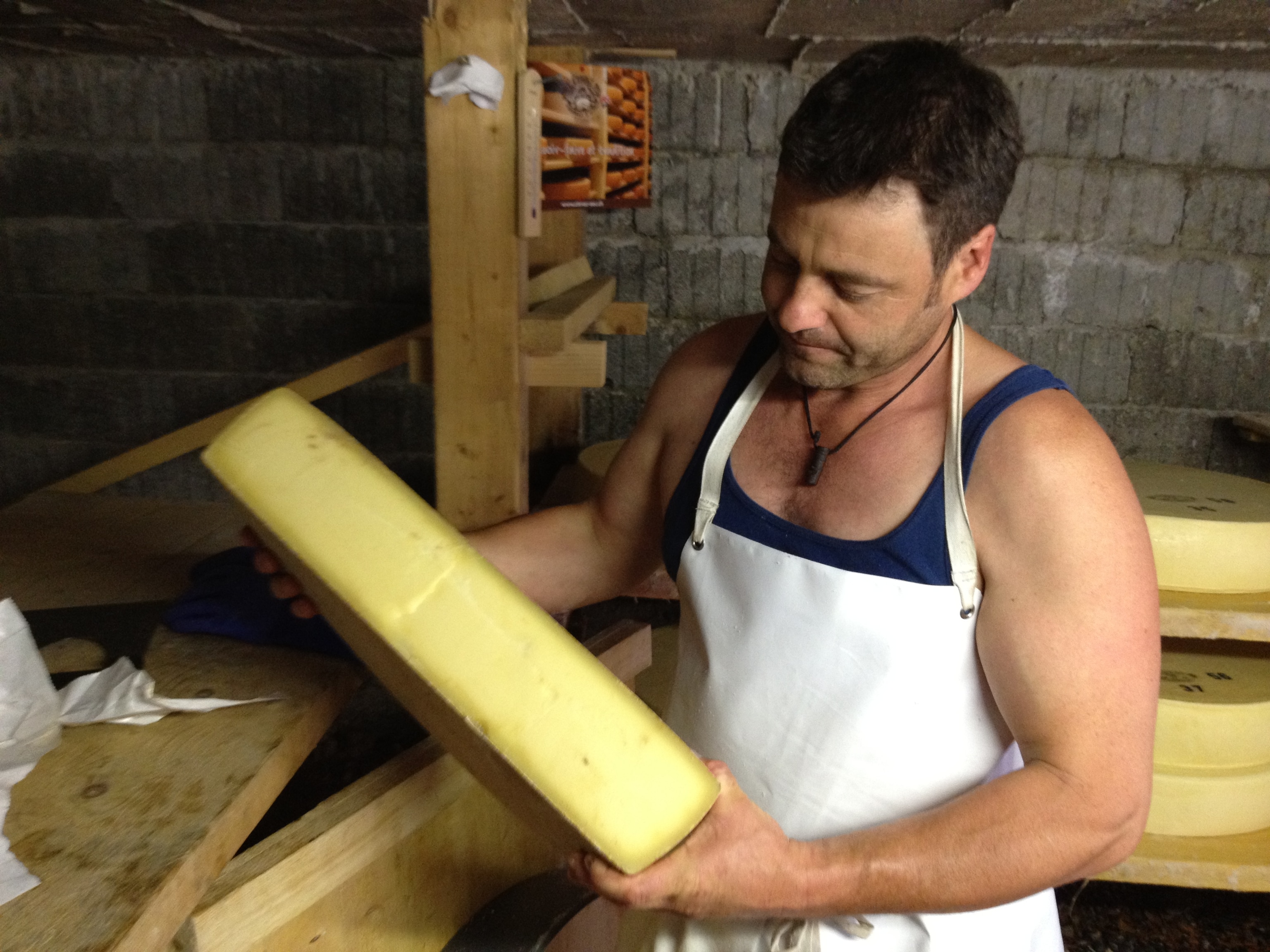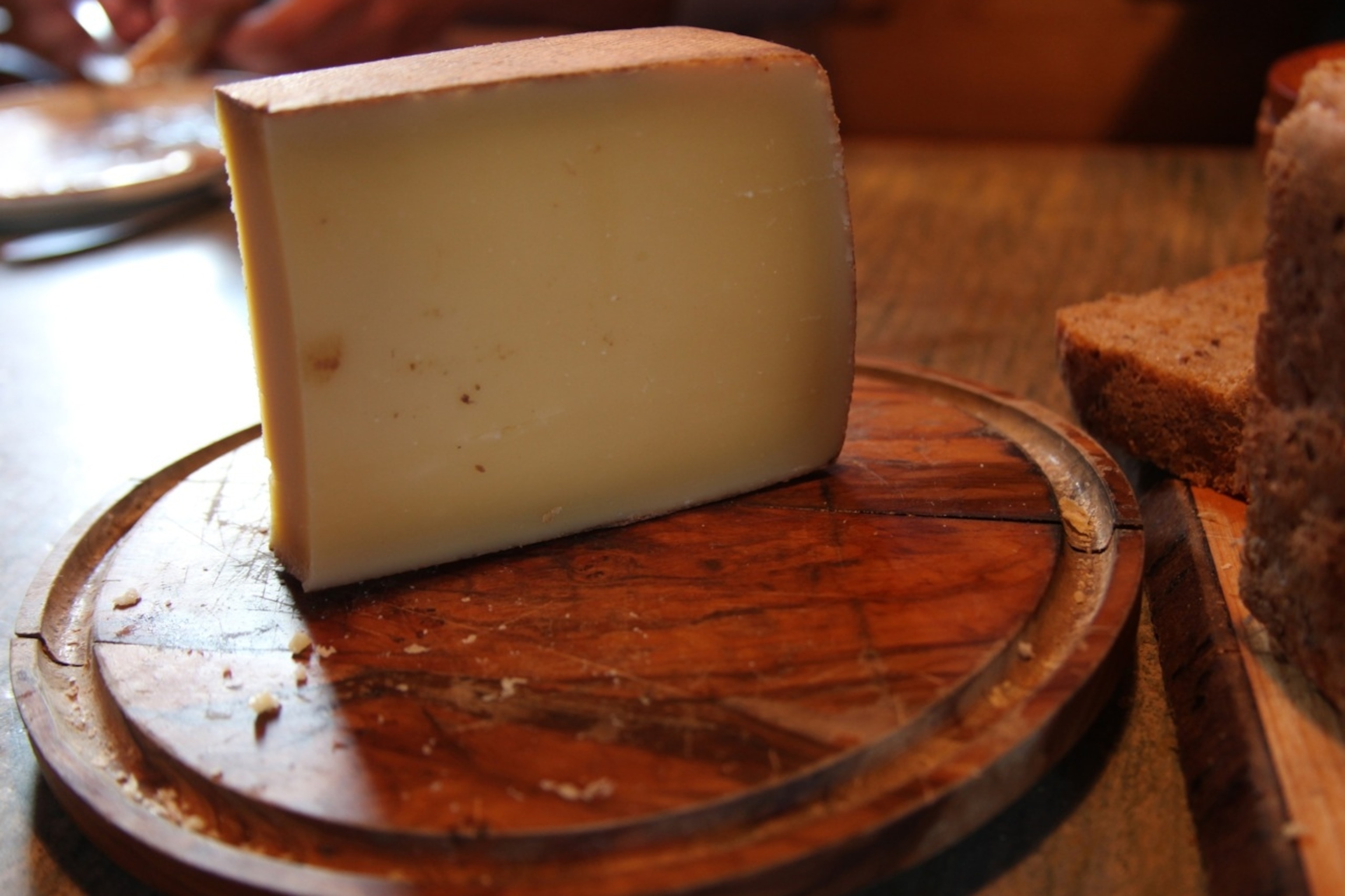Real Swiss Cheese
“If the cheese has holes, then that’s a problem.”
So says Swiss cheesemaker Dominique Yersin as he pats one of his giant wheels of cheese, each one weighing more than 50 pounds.
In America, most of us live with “Swiss cheese“—a white and rubbery cheese with a specific flavor and trademark holes. In fact, most us want our Swiss cheese to have holes in it. In Switzerland though, most cheesemakers do everything they can to avoid holes forming in their cheese.
The main exception is Emmentaler, which is quite delicious but has a much milder flavor then some of the longer-aged semihard cheeses. If anything vaguely resembles the holey-white chunks of rubber sold as “Swiss cheese” back home, then it’s Emmentaler (although Emmentaler is so much better).
“If there are holes, that means there is water—or whey—inside the cheese, which means it won’t last as long,” Dominique explains, referring to the cheese he makes: L’Etivaz.

L’Etivaz (Leh-tee-vah) is an AOC (Appelation d’origine contrôlée), which means that the authenticity of the brand, flavor, and the making of the cheese are all protected by specific regulations. Similar to France, Switzerland has a wonderful culinary tradition of terroir—food that’s made only in certain locales, including a large number of AOC cheeses like L’Etivaz.
Only around 70 families are licensed to make true L’Etivaz; the following are just a few of the highly regulated specifications for this local Alpine cheese:
- Cows must graze in Alpine pastures between 1,000 and 2,000 meters high.
- Pastures must fall within the boundaries of the registered AOC Etivaz region in Switzerland.
- Cheese must be curdled over a pinewood fire.
- Cheese must be made between mid-May and mid-October.
- Cheese must age a minimum of 135 days.
Biting into a rich and floral piece of L’Etivaz is like tasting a little piece of Switzerland. A good cheese sniffer can identify over 45 distinct aromas in a ripe piece of L’Etivaz—many of which derive from the bouquet of herbs that the cows are eating in the high Alpine pasture, like purple clover, oregano, violets, cumin, and narcissus (the higher the altitude, the more aromas).

It takes 11 liters of cows’ milk to make just one kilogram of cheese and from his current herd of 29 cows, Dominique makes only two cheeses per day. He starts at 5 a.m. and doesn’t finish before 11 in the morning. Once he’s molded, pressed and salted the cheese, he delivers the cheeses to the village in the valley below—at L’Etivaz, where the cheese is aged in a climate-controlled “cave.” The aging process or affinage is vital to creating the right flavor of the cheese. Early on, the cheese are scrubbed with a salty wash that helps create the crust on the outside. Then, they are turned and flipped regularly to ensure they ferment thoroughly and equally on all sides. The cheeses are flipped manually at first, but once they gain a certain firmness, L’Etivaz uses a robot to turn the cheeses in the cave.
Most stores and restaurants will serve L’Etivaz that’s been aged seven to eight months, although this is still considered a “young cheese.” Real connoisseurs tend to like their L’Etivaz aged up to two years, and they even make a variety called Rebibe, which is aged for three years and has a completely different taste—resembling something more like Parmesan.
Like all AOC cheeses in Switzerland, L’Etivaz is still strictly quality-controlled. Typically, three to five experts will visit at the end of each season and actually grade all the cheeses on a number of points that add up to a maximum of 20. Anything graded under 17 is automatically “declassified” and will not be sold as L’Etivaz. Also, the local cheesemakers are paid for all their cheese only after it’s been graded, so it can be a suspenseful summer.
Last year, Dominique received a grade of 19.5 on his cheese, which still makes him smile this year as he produces another full season. He learned the tradition of L’Etivaz from his father and so much of what he does—from milking the cows, to testing the temperature, to judging the moment when the curds are ready—all comes from experience.
Last year, L’Etivaz produced exactly 18,313 cheeses—of which the majority are consumed here in Switzerland. While more well-known AOC brands like Gruyère and Emmentaler are exported, L’Etivaz is one cheese that it’s worth traveling to Switzerland to eat en pays.
The flavor is splendid and unique, the culinary experience entirely Swiss . . . and the cheese completely free of holes.

Related Topics
Go Further
Animals
- How can we protect grizzlies from their biggest threat—trains?How can we protect grizzlies from their biggest threat—trains?
- This ‘saber-toothed’ salmon wasn’t quite what we thoughtThis ‘saber-toothed’ salmon wasn’t quite what we thought
- Why this rhino-zebra friendship makes perfect senseWhy this rhino-zebra friendship makes perfect sense
- When did bioluminescence evolve? It’s older than we thought.When did bioluminescence evolve? It’s older than we thought.
- Soy, skim … spider. Are any of these technically milk?Soy, skim … spider. Are any of these technically milk?
Environment
- Are the Great Lakes the key to solving America’s emissions conundrum?Are the Great Lakes the key to solving America’s emissions conundrum?
- The world’s historic sites face climate change. Can Petra lead the way?The world’s historic sites face climate change. Can Petra lead the way?
- This pristine piece of the Amazon shows nature’s resilienceThis pristine piece of the Amazon shows nature’s resilience
- Listen to 30 years of climate change transformed into haunting musicListen to 30 years of climate change transformed into haunting music
History & Culture
- Meet the original members of the tortured poets departmentMeet the original members of the tortured poets department
- Séances at the White House? Why these first ladies turned to the occultSéances at the White House? Why these first ladies turned to the occult
- Gambling is everywhere now. When is that a problem?Gambling is everywhere now. When is that a problem?
- Beauty is pain—at least it was in 17th-century SpainBeauty is pain—at least it was in 17th-century Spain
Science
- Here's how astronomers found one of the rarest phenomenons in spaceHere's how astronomers found one of the rarest phenomenons in space
- Not an extrovert or introvert? There’s a word for that.Not an extrovert or introvert? There’s a word for that.
- NASA has a plan to clean up space junk—but is going green enough?NASA has a plan to clean up space junk—but is going green enough?
- Soy, skim … spider. Are any of these technically milk?Soy, skim … spider. Are any of these technically milk?
Travel
- Could Mexico's Chepe Express be the ultimate slow rail adventure?Could Mexico's Chepe Express be the ultimate slow rail adventure?
- What it's like to hike the Camino del Mayab in MexicoWhat it's like to hike the Camino del Mayab in Mexico